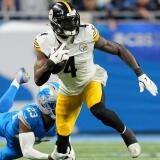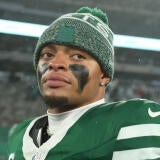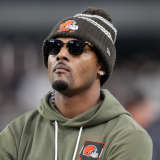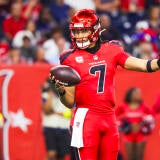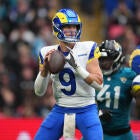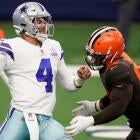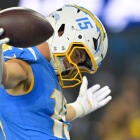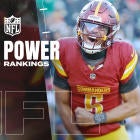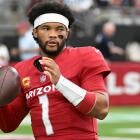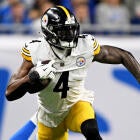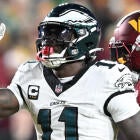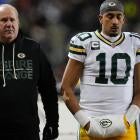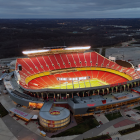Ranking the greatest unit nicknames in NFL history: Steel Curtain, Doomsday, Orange Crush among all-time best
These nicknames stand out from the rest
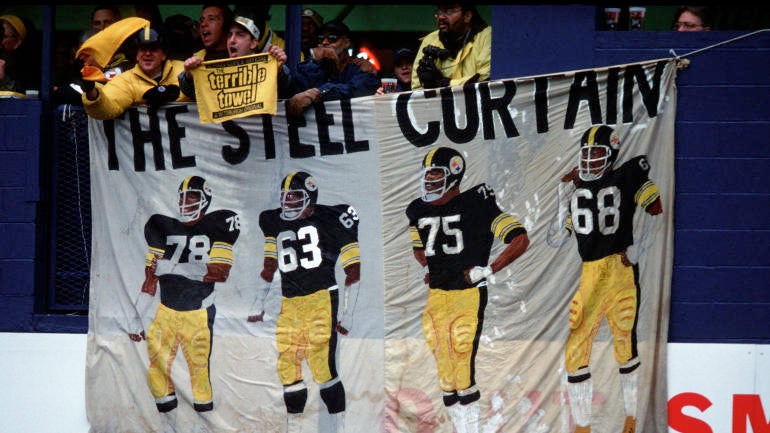
Through the NFL's first 102 seasons, several units were so memorable that a nickname was bestowed upon them. Some nicknames captured their effectiveness as a unit, while others perfectly depicted their utter dominance. A few of them were just fun and creative while being more of a reflection of the fan base than of the actual unit.
It's the offseason, and while you're probably itching to read yet another Aaron Rodgers story, we invite you to check out our ranking our the top unit nicknames in NFL history. Before you do, here's the criteria we used when putting our list together.
- Coolness of the nickname
- How memorable was the unit
- How well the nickname/unit fit together
Without further ado, let's get started.
10. New York Sack Exchange
- New York Jets front four, early 1980s
Not many nicknames capture the essence of an era and a city much like this one. The '80s was a wild time in New York City, and the Jets of that era were an extension of that craziness. The New York Stock Exchange had plenty of style, they also had substance. The star of the unit, Mark Gastineau, was a hard-charging, gregarious player who recorded a then-NFL-record 22 sacks in 1984. The brains of the operation was Joe Klecko, who earned Pro Bowl selections at four different positions.
Led by Klecko's 21.5 sacks, the Jets led the NFL with 66 sacks in 1981. The success of Gastineau, Klecko, Marty Lyons and Abdul Salaam led New York to an AFC Championship Game appearance in 1982. The unit, despite losing Salaam after the '83 season, led the Jets to back-to-back playoff appearances in 1985-86. The Jets' lack of postseason success is what ultimately led to them not being higher on this list.
The story of the 1981 New York #Jets, the "Talk of the Town." The season the New York Sack Exchange cemented itself and the organization finally made it back to the playoffs. (NFL Films)
— Jets X-Factor (@jetsxfactor) August 10, 2020
FULL VIDEO: https://t.co/5OqpYmn5Aj
JET X: https://t.co/pqEImVyzzA pic.twitter.com/ujeR3vSvTm
9. The Hogs
- Washington offensive line, 1980s/early '90s
Washington's powerful offensive line paved the way to three titles and four Super Bowl appearances. The most iconic version of the Hogs was the unit that was first given the nickname. The '82 unit, a group that included Russ Grimm, Joe Jacoby and Mark May, powered an offense that featured ageless fullback John Riggins. Behind the Hogs, "The Diesel" ran for a playoff record 610 yards in four playoff games. Riggins and the Hogs dominated Super Bowl XVII. Riggins ran for 168 yards on a Super Bowl record 38 carries in the victory over the Dolphins. His legendary 42-yard touchdown run put Washington in front to stay.
No. 54: 1982 @Redskins, @SuperBowl XVII Champions #HTTR
— NFL (@NFL) November 9, 2019
📺: #NFL100 Greatest Teams on @NFLNetwork pic.twitter.com/pHZUq8wlc4
8. Orange Crush
- Broncos defense, late '70s
This nickname is more than just awesome. It symbolizes the first great era of Broncos football, an era that included the franchise's first trip to the Super Bowl. The Broncos' 1977 AFC Championship run was fueled by an aggressive defense that boasted five Pro Bowlers: defensive end Lyle Alzado, linebackers Randy Gradishar and Tom Jackson, cornerback Louis Wright and safety Bill Thompson.
Denver's defense put up impressive performances over the Steelers and Raiders -- offenses that featured a combined 12 future Hall of Famers -- in the playoffs before holding their own against the Cowboys' prolific offense in Super Bowl XII. Unfortunately for them, the Cowboys' defense was historically good that day, as Dallas forced eight turnovers in a 17-point win.
7. No Name
Dolphins defense, early 1970s
Miami's bland, yet iconic nickname was born from the Dolphins' perception that they were underrated and under-appreciated. That was probably true, as only one member of that defense -- linebacker Nick Buoniconti -- is in the Hall of Fame. They may be under-represented in Canton, Ohio, but the Dolphins' "No Name" defense has a unique place in NFL history as the only unit that did not lose a game for an entire season.
The '72 Dolphins defense -- which boasted the league's top-ranked unit during the regular season -- did not allow a single point in Super Bowl VII. Miami allowed just one touchdown in Super Bowl VIII, as Miami's defense played a massive role in the Dolphins going a combined 32-2 during the '72-73 seasons. Fittingly, the MVP of Miami's first Super Bowl win was a defensive player: safety Jack Scott, whose two interceptions helped the Dolphins secure the franchise's first Super Bowl win.
6. Monsters of the Midway
This might be the coolest nickname in NFL history. Unfortunately, the somewhat confusing origins of the nickname dropped it a few pegs on this list. The nickname, which was originally given to the University of Chicago's football team, was unofficially transferred to George Halas' Bears after the school dropped their football program. The early '40s Bears were dominant, and the nickname certainly added to their fame. But the "Monsters of the Midway" moniker didn't allude to a particular unit during that point in time.
The nickname made a resurgence with the Bears' Super Bowl run in 1985. It perfectly summed up the dominance of Buddy Ryan's bunch, but similar to the 1940s, no specific unit officially claimed the nickname, even though it is largely attributed to the '85 Bears defense. Led by Mike Singletary, Richard Dent, Dan Hampton, Otis Wilson, Steve McMichael, Dave Duerson, Gary Fencik and William "Refrigerator" Perry, the unit allowed 10 total points during its three playoff wins, with seven of those points coming in garbage time late in Super Bowl XX, a game Chicago won 46-10.
“A punky, rebellious, athletically gifted, smash mouth, boastful… a fantastic squad.”
— NFL Network (@nflnetwork) November 16, 2019
The 1985 @ChicagoBears was a very memorable team 👇 #NFL100
📺: NFL 100 GREATEST TEAMS on NFL Network pic.twitter.com/HB93MzCrkL
5. Doomsday
- 1970s Cowboys defense
Before the Cowboys were branded as "America's Team," their defense was given one of the greatest nicknames ever. The Cowboys' original "Doomsday" defense led the franchise to its first Super Bowl win. Led by linemen Bob Lilly and Larry Cole, linebackers Chuck Howley and Lee Roy Jordan, and defensive backs Mel Renfro, Herb Adderley and Cliff Harris, the Cowboys held the Dolphins to a mere three points in their Super Bowl VI victory.
Harris, Cole, Renfro and safety Charlie Waters were also part of the team's second Super Bowl win. By that time, Doomsday added several new stars that included Randy White and Harvey Martin, who shared MVP honors in Dallas' Super Bowl win over Denver. The '77 Cowboys defense also included the 6-foot-9 Ed "Too Tall" Jones and Thomas "Hollywood" Henderson, who in 2019 declared Doomsday the greatest defensive unit of all time.
4. Purple People Eaters
- Late 1960s/1970s Vikings defensive line
Named after the hit 1950s song, the Vikings' defensive line was perfectly personified by its incredibly awesome nickname. Minnesota's defensive front was as terrifying as it was talented. The group was led by Alan Page, the first defensive player to win league MVP. Page was flanked by fellow Hall of Famer Carl Eller, Jim Marshall and Gary Larsen. Combined, Page, Eller and Marshall tallied an astounding 412.5 sacks during their careers. The group played a vital role in the Vikings winning the 1969 NFL title, Minnesota's first and last championship. Page, Eller and Marshall played in four Super Bowls together, but the trio came up short in each game.
3. Greatest Show on Turf
- Late '90s/early 2000s Rams offense
A nickname that really hasn't faded over time. The Rams' offense was the best show on any surface. Led by two-time MVP Kurt Warner, 2000 league MVP Marshall Faulk, receivers Isaac Bruce, Torry Holt, Az-Zahir Hakim, and offensive lineman Orlando "Pancake" Pace, the Rams led the NFL in scoring each season from 1999-01. Warner's 414 passing yards spearheaded the Rams' thrilling 23-16 win over the Titans in Super Bowl XXXIV. Faulk, acquired via a trade with the Colts during the '99 offseason, became the second player in league history to record 1,000 rushing and receiving yards in the same season.
“The whole team just had a swag to them, and it was electrifying!” 💥@Nelly_Mo on the 1999 St. Louis Rams 👇 #NFL100
— NFL Network (@nflnetwork) November 16, 2019
📺: NFL 100 GREATEST TEAMS on NFL Network pic.twitter.com/NRnlr52AkA
2. Fearsome Foursome
- 1960s Rams defensive line
The NFL was growing in popularity in the '60s, which might be why this nickname is still revered by generations of football fans. The Rams' vaunted defensive line, which consisted of Deacon Jones, Merlin Olsen, Rosey Grier and Lamar Lundy, was once hailed by Hall of Fame linebacker Dick Butkus as the greatest defensive line of all time. Olsen's contributions to the Rams earned him a spot in the Hall of Fame. Olsen is flanked in Canton by Jones, who tallied 173.5 sacks during his legendary career. Fittingly, Jones is created with coining the term "sack."
The unit helped turn the Rams from an irrelevant team to a title contender by the end of the decade. The Rams also showed a growing football audience that hard-hitting, physical football can be as enjoyable to watch as high-scoring affairs.
The @RamsNFL Fearsome Foursome 🎶
— NFL Throwback (@nflthrowback) November 9, 2019
More #NFL100 rewinds now streaming on @TIDAL: https://t.co/HdqaOJGkN4 pic.twitter.com/LKgU96jMRY
1. Steel Curtain
- Early/mid 1970s Steelers defensive line
While the entire unit has been hailed the Steel Curtain, the nickname -- the greatest for a unit in league annals -- was created initially for Pittsburgh's dominant defensive front. Led by two-time Defensive Player of the Year Joe Greene, perennial Pro Bowler L.C. Greenwood, and menacing linemen Dwight White and Ernie Holmes, the unit led the Steelers to their first two Super Bowl wins of the decade.
The unit was at its apex during the 1974 playoffs. It held O.J. Simpson to a mere 49 rushing yards in the divisional round. A week later, it limited the Raiders' powerful offense to 29 yards rushing. In Super Bowl IX, it shut out Minnesota's offense while holding the Vikings to 102 total yards. Greene had an interception and a fumble recovery, while White recorded the first safety in Super Bowl history.
A team comprised of legends.
— Pittsburgh Steelers (@steelers) November 9, 2019
The 1974 #Steelers take #43 in the #NFL100 Greatest Teams countdown. pic.twitter.com/POLvSEwkAb
For an encore, the Steel Curtain sacked Roger Staubach seven times in Super Bowl X. It's pressure also contributed to three interceptions, as Pittsburgh won its second of four Super Bowls during the decade.
The unit also had historical cultural significance, as the quartet was featured on the cover of Time magazine. Less than a decade following the nation's civil rights movement, the group's appearance on the cover signified the social and cultural growth that was taking place in society. It also continued to popularize the NFL while showcasing the personalities of the players who dominated the sport.
The Time article revealed a quote that demonstrated how dominant the Steel Curtain was. The quote was from Vikings Pro Bowl running back Chuck Foreman during Super Bowl IX.
"C'mon, you mothers," Foreman told the group, "give us a yard."
The Steel Curtain obliged, sort of, yielding 17 rushing yards on 21 carries. Such was life when playing against the greatest defensive line of all time.


